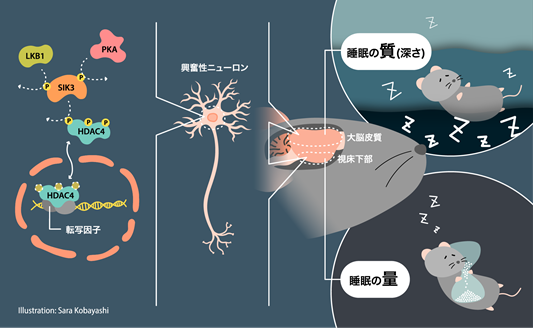てんかんなどの神経疾患の治療に新たなアプローチを提供する方法です。 Method offers new approach to treating neurological conditions such as epilepsy
2022-12-07 ハーバード大学
細胞膜のキャパシタンスを変えるために、研究者たちは、細胞膜の表面に絶縁性または導電性ポリマーの形成を誘発できる光感受性の酵素を使った。
この酵素は、特定の神経細胞の細胞膜を標的とするように設計することができる。研究チームは、酵素が特定の膜に付着した後、青色波長の光でニューロンを照らすと、数分以内に膜上に絶縁性または導電性の被膜が形成されることを確認した。その結果、絶縁性ポリマーの膜を持つニューロンはより興奮しやすくなり、導電性ポリマーの膜を持つニューロンはより興奮しにくくなることが示された。
研究チームは、光への露出を調整することで興奮性を調整できることを発見した。光への露出時間が長いほど、コーティングはより絶縁性または導電性になる。また、研究チームは、興奮性の変化が最大3日間持続することも確認した。これは、シャーレの中で神経細胞を生きたまま維持できる期間である。
<関連情報>
- https://seas.harvard.edu/news/2022/12/changing-intrinsic-behavior-neurons
- https://www.science.org/doi/10.1126/sciadv.ade1136
単一ニューロンの興奮性調節を目指した電気機能性高分子の光遺伝学的重合および集合化 Optogenetic polymerization and assembly of electrically functional polymers for modulation of single-neuron excitability
Chanan D. Sessler,Yiming Zhou,Wenbo Wang,Nolan D. Hartley,Zhanyan Fu,David Graykowski,Morgan Sheng,Xiao Wang,Jia Liu
Science Advances Published:7 Dec 2022
DOI: 10.1126/sciadv.ade1136

Abstract
Ionic conductivity and membrane capacitance are two foundational parameters that govern neuron excitability. Conventional optogenetics has emerged as a powerful tool to temporarily manipulate membrane ionic conductivity in intact biological systems. However, no analogous method exists for precisely manipulating cell membrane capacitance to enable long-lasting modulation of neuronal excitability. Genetically targetable chemical assembly of conductive and insulating polymers can modulate cell membrane capacitance, but further development of this technique has been hindered by poor spatiotemporal control of the polymer deposition and cytotoxicity from the widely diffused peroxide. We address these issues by harnessing genetically targetable photosensitizer proteins to assemble electrically functional polymers in neurons with precise spatiotemporal control. Using whole-cell patch-clamp recordings, we demonstrate that this optogenetic polymerization can achieve stepwise modulation of both neuron membrane capacitance and intrinsic excitability. Furthermore, cytotoxicity can be limited by controlling light exposure, demonstrating a promising new method for precisely modulating cell excitability.


